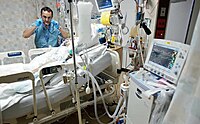
Photo from wikipedia
Background Muscle ultrasound represents a promising approach to aid diagnoses of neuromuscular diseases in critically ill patients. Unfortunately, standardization of ultrasound measurements in clinical research is lacking, making direct comparisons… Click to show full abstract
Background Muscle ultrasound represents a promising approach to aid diagnoses of neuromuscular diseases in critically ill patients. Unfortunately, standardization of ultrasound measurements in clinical research is lacking, making direct comparisons between studies difficult. Protocols are required to assess qualitative muscle changes during an ICU stay in patients at high risk for the development of neuromuscular acquired weakness (ICUAW). Methods We conducted a retrospective, observational analysis comprised of three prospective observational studies with the aim of diagnosing muscle changes by ultrasound measurement of the quadriceps muscle. Different protocols were used in each of the three studies. In total, 62 surgical, neurocritical care and trauma intensive care patients were serially assessed by different ultrasound protocols during the first week of critical illness. The relative change in ultrasound measurements was calculated for all possible locations, methods and sides. Comparison was obtained using mixed effect models with the location, the height and the side as influencing variables and patients as fixed effect. The relationship between variables and outcomes was assessed by multivariable regression analysis. Results Ultrasound methods and measurement sites of the quadriceps muscles from all protocols were equally effective in detecting muscle changes. During the first week of an ICU stay, two groups were identified: patients with decreased muscle mass on ultrasound (n = 42) and a cohort with enlargement (n = 23). Hospital mortality was significantly increased in the cohort with muscle swelling (8 (19%) versus 12 (52%), p = .013). Conclusions Different approaches of ultrasound measurement during critical-illness are equally able to detect muscle changes. While some patients have a decrease in muscle mass, others show swelling, which may result in a reduced probability of surviving the hospital stay. Causative reasons for these results still remain unclear.
Journal Title: Journal of Intensive Care Medicine
Year Published: 2022
Link to full text (if available)
Share on Social Media: Sign Up to like & get
recommendations!